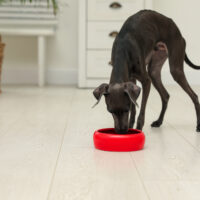Why Your Dog Is Actually The One In Charge

You come home from a long day at work, excited to see your furry friend wagging their tail at the door. You walk in and they’re calling all the shots, demanding attention, and jumping on you before you even have time to take off your shoes. You then head into the kitchen and your dog rushes infront, through an open door ahead of you. What about if your dog pulls on the leash or lies on your bed? As much as we adore our dogs, sometimes it feels like they’re in charge. But what if we told you that they actually are? And asserting dominance in many more ways than your realise.
In this article, we’ll dive into the topic of dog dominance, explore its negative impact on both dogs and owners, and give you the tools you need to establish a more balanced relationship with your four-legged pal. From understanding the differences between dogs and their wolf ancestors to becoming the leader of the pack, we’ll cover everything you need to know to make sure you’re the one in charge. So, whether you’re a seasoned dog owner or just thinking about bringing a pup into your life, this article is for you.
Dogs v’s Wolves
To understand why your dog is in charge, it’s important to look at the origins of our furry friends. Domestic dogs are descendants of wolves, but they have evolved significantly over time.
Unlike their wild ancestors, dogs have been selectively bred to live and work with humans, similar to how we are genetically similar to chimpanzees. This has resulted in a unique set of traits, including a deep desire to please their owners and a willingness to adapt to human environments. However, dogs still retain some wolf-like tendencies, which can sometimes lead to issues with dominance. So, what exactly is dog dominance and how does it manifest in our furry pals?
What Is Dog Dominance?
Domestic dogs are social animals and have a well-defined hierarchy in their packs. In the wild, wolves establish dominance through aggressive displays such as snarling, baring teeth, and growling. The alpha wolf, the head of the pack, asserts its position through physical force and is responsible for maintaining order and harmony within the group.
Similarly, in domesticated dogs, dominance is a behavioral trait that refers to the dog’s desire to exert control over other dogs, animals, or humans. Dominant dogs display a variety of behaviors such as growling, barking, and snapping to establish their authority. They may also engage in territorial marking, possessiveness over food or toys, and refuse to obey commands.
It’s important to note that not all dogs exhibit dominant behavior. Dobermann dogs can be very dominant, where as Basset hounds are the opposite, and are very laid back.
A confident and assertive dog can be a joy to be around, but when a dog’s dominance becomes excessive, it can lead to behavioral problems. For example, a dog that constantly asserts its dominance over other dogs can become aggressive and may even attack other dogs. Similarly, a dog that displays dominance towards its owner can become disobedient, destructive, and even dangerous.
Understanding dog dominance is essential for all dog owners. It allows us to recognize when our dogs are attempting to assert their authority and take corrective action to prevent negative behaviors from developing. In the next section, we’ll explore the negative impact of dominance on dogs and people.
The Negative Impact Of Dominance On Dogs And People
Understanding dog dominance is crucial for all dog owners. While it’s natural for dogs to assert their authority, excessive dominance can lead to behavioral problems and even pose a threat to other dogs and people. Dominant dogs may exhibit aggression towards other dogs, and towards their owners, which can lead to destructive and disobedient behavior.
When a dog thinks it’s in charge, it may become stubborn and refuse to obey commands. This can lead to frustration and tension between the dog and its owner, creating a negative environment for both. Moreover, a dog that’s excessively dominant may feel the need to protect its perceived position of authority, leading to stress and anxiety.
Domination-based training techniques, such as physical punishment or harsh reprimands, can worsen the situation, leading to fear and aggression in dogs. It’s important to remember that dogs respond best to positive reinforcement techniques, such as reward-based training, to encourage good behavior.
Excessive dog dominance can have severe negative impacts on both dogs and their owners, leading to behavioral problems, tension, anxiety, and aggression. Recognizing the signs of dominance and reacting positively with appropriate training techniques can help prevent negative behaviors from developing.
Are You Or Your Dog In Charge?
It can be difficult to determine who’s in charge in your dog-human relationship, but it’s important to establish a clear hierarchy to maintain a healthy and happy dynamic. Dogs are pack animals and crave structure and leadership from their owners. Without a clear leader, they often take on the role themselves, leading to behavioral issues and tension.
So, are you or your dog in charge? Some signs that your dog may be the dominant one include refusing to follow commands, growling or snapping when asked to do something they don’t want to do, and jumping on people or furniture. On the other hand, obedient dogs who follow commands and respect boundaries are usually more submissive.
If you suspect your dog is in charge, don’t panic. With positive reinforcement training techniques, you can reestablish yourself as the leader and improve your dog’s behavior.
How To Become The Dogs Leader
To establish yourself as your dog’s leader, you must first focus on the basics of training. Consistency is key: ensure that everyone in your household is using the same commands, tone of voice, and rewards for good behavior. Implementing a routine for feeding, walking, and playtime can also add structure to your dog’s day, giving them a sense of security and stability.
Start with basic obedience training, such as sit, stay, come, and heel. Reward good behavior with treats, praise, and affection. If your dog isn’t responding to your commands, remain calm and patient. Avoid using physical punishment or yelling, as this can damage your relationship with your dog and cause anxiety or fear.
Once your dog has mastered basic obedience, you can focus on advanced training such as agility and tricks. This not only strengthens the bond between you and your dog, but it also channels their energy towards productive activities.
Remember, dogs are not wolves or human. Becoming your dog’s leader isn’t about asserting dominance or control. It’s about creating a healthy and mutually respectful relationship. Through positive reinforcement and consistent training, you can establish yourself as a trusted authority figure in your dog’s life. And in turn, your dog will become a happier, more well-behaved companion.
Routine And Consistency
Establishing yourself as your dog’s leader requires more than just basic obedience training. It’s important to establish a routine and be consistent in your approach to training. Dogs thrive on structure and predictability, so setting clear expectations and sticking to a routine can greatly benefit your training efforts.
Consistency is key when it comes to training. It’s important to use the same commands and methods each time you work with your dog. This helps your dog understand what is expected of them and makes it easier for them to follow through with your commands. Consistency also helps you establish your role as the leader in your dog’s life.
Setting a routine for training can also help your dog understand what’s expected of them. Consistent training sessions help your dog develop good habits and make it easier to reinforce those habits over time. This routine can also help you stay committed to training, making it easier to follow through with your plans and achieve your goals.
By using positive reinforcement and being consistent in your approach, you can create a strong and respectful relationship with your dog.
Training And Boundaries
When it comes to training your dog and setting boundaries, consistency is key. Dogs thrive on routine and structure, so establishing a regular training schedule can help them understand what is expected of them. It’s important to approach training with a positive attitude and to use positive reinforcement techniques, such as rewarding good behavior with treats or praise.
One effective way to establish boundaries is to use cues or commands that signal to your dog what is and isn’t allowed. For example, teaching your dog the command “off” can be helpful for keeping them off the furniture. Similarly, teaching them to “stay” or “come” can help keep them safe in potentially dangerous situations.
It’s also important to set realistic goals for both yourself and your dog. Rome wasn’t built in a day, and neither is a well-trained dog. Consistency and patience are key to making progress, and celebrating small successes along the way can help keep you motivated.
By using these techniques in conjunction with clear boundaries and consistent training, you can create a solid foundation for a strong and respectful relationship with your furry friend.
The Power Of Rewards And Positive Reinforcement
Consistency and patience are key to making progress when it comes to training your dog. But did you know that the way you reward your dog can have a significant impact on their behavior?
Positive reinforcement is a powerful tool in dog training. It involves rewarding your dog for good behavior, rather than punishing them for bad behavior. This can be anything from a treat or a toy to praise and affection. When your dog knows that good behavior will result in a positive outcome, they are more likely to repeat that behavior in the future.
On the other hand, negative reinforcement, such as yelling or hitting, can actually make your dog’s behavior worse. This can lead to fear, anxiety, and aggression.
It’s important to be consistent with your rewards and to use them immediately after the desired behavior occurs. This helps your dog make the connection between their behavior and the reward. Over time, you can gradually decrease the frequency of rewards, but it’s still important to continue to praise and reinforce good behavior.
Using rewards and positive reinforcement in conjunction with clear boundaries and consistent training can create a strong and respectful relationship between you and your dog. So next time your dog does something good, give them a treat and let them know they’re doing a great job. It’s a win-win for both of you.
In the conclusion, we’ll summarize why it’s important to understand your dog’s behavior and how you can establish yourself as the true leader in the relationship.
While it may seem like our dogs are the ones calling the shots, it’s important to establish a balanced relationship with clear boundaries and consistent routines. Dominance has negative impacts on both dogs and people, so by becoming the leader through training, setting boundaries, and positive reinforcement, we can have a healthier and happier relationship with our beloved pets. As the saying goes, “a well-trained dog will make no attempt to share your lunch. He will just make you feel so guilty that you cannot enjoy it.” So start today and enjoy a guilt-free lunch with your furry companion!


